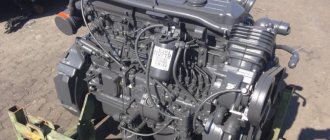Viva la VITO: morals and nerves
Pavel Gamankov, photo by the author
| Chassis manufacturer: | Daimler AG et Vitoria (Spain) |
| Model: | Mercedes-Benz Vito CDI 111 W639 |
| Start of sales in Russia: | 2004 |
| Price: | 27,400 euros |
How to classify it? An elite small-tonnage vehicle or a mini-van with an elite capacity? Obviously, the burghers did not just create a spacious commercial “bun” with the nerves of a car and the character of a truck. To the old van they added some attributes, aesthetics, comfort, brains and amputated all the shortcomings.
The bullet-shaped front end with sharpened optics and the embossed stylobate of the belt line give this shell monstrous dynamism. There appears to be a capsule inserted into the back of the van. Click the trigger on it and it will fly like a bullet through the back streets. No matter how you look at the Vito, it reveals primarily passenger notes. The styling traces the discoveries of Giorgetto Giugiaro, who first used lei for the Isuzu Piazza 25 years ago.
These impetuous motivations were clearly lacking in the previous generation Vito with the “638” body, which, despite the stability due to front-wheel drive, felt like a milked cow in corners. Clumsy and heavy, the car dragged its belly along curbs and gullies of unrepaired asphalt, and the advantages of front-wheel drive turned out to be insignificant before the long icy climb. To this must be added the limited rotation angle.
However, the new product does not shine with super cross-country ability, but now you can turn around in one go on a street with two, rather than four, lanes. The new product uses classic rear-wheel drive, traditional for Mercedes-Benz cars.
The black plastic bumpers of the van, combined with the side lines of the molding, create a textured strip along the entire perimeter of the car, which, according to transport safety adherents, has practical meaning: a car with a wide belt line beam, according to research by German specialists at Daimler-Benz, conducted in 1971, has less chance of getting into an accident.
A cargo van with side sliding and rear lift doors was tested. The installation of rear swing doors is not provided even as an option, which can be considered a clear hint from the designers towards exclusively urban use of the car. This van in the city center may never be able to drive its stern up to the unloading point. And loading and unloading delicate cargo in the rain and snow in a city center filled with cars is better with the rear door raised! The main thing is to park the car with its stern closer to the porch.
The use of rear vertical lights made it possible to make the lift door as wide as possible, and the door opening to be almost square (1350x1230), which makes it possible to load even standard Euro pallets into the body. But you shouldn’t forget about the carrying capacity of the Spanish-German truck - in the standard configuration it is limited to 980 kg. As our tests have shown, it is dangerous to load more, the rear spring suspension noticeably squats even with the permitted loads, and with full ballasting on the radius of the exit ramps of Moscow interchanges, it seemed that now the rims at children's 50 km / h would come off the tires and the van would tip over. Nothing happened even at 70 km/h. The tires squealed like a half-cut pig, but the Vito held the road like a Porsche. There are, however, modifications of the Mercedes-Benz Vito with reinforced suspension, where the load capacity is officially increased to 1120 kg, but these cars have another drawback - you can drive into the center of Moscow in such a small vehicle only due to an oversight by the traffic police. In other regions of the country, where axle load restrictions are more flexible, it is worth remembering that an increase in load capacity by 140 kg entails a change in the design and behavior of the vehicle. This means additional discomfort from the “shimmy” effect, a different cost and a new driving experience. Verdict: The Vito is a high-speed express train. Capsule for fast delivery of cargo.
Tales for VIP
The more tests we conduct, the larger the range of vehicles we cover, the more difficult it becomes to find competitors for comparison. We have to choose other comparison criteria. So this time we decided to list the data of machines with a carrying capacity of up to 1000 kg in the table. These are the numbers that limit entry into the center of Moscow, where similar equipment is mainly sold. Therefore, when viewing test data, keep in mind that the total weight of the vehicles being driven is different and they are, in general, intended for transporting sometimes completely opposite groups of goods. We hope this comparison will help you understand how much fuel you will save if you take a minivan rather than a cargo van to transport printed materials.
Interior decoration
It’s tempting to say that behind the wheel of the Vito you feel like the driver of a passenger car. But this is only partly true. You experience the first curious sensations already upon landing. Putting your foot on the step, you grab the handrail, but there’s nothing to grab onto with your hand! The inside of the A-pillar begs for a handle, but it’s not there! Therefore, the first time you have to frantically literally jump into a high-positioned chair, like into a jeep. Then you get used to it: the harsh everyday life of transporting heavy loads has begun!
The front console is horizontally divided into two zones, made of different materials in shades of gray. The absence of noise from the oncoming flow creates a calm and comfortable atmosphere in the cabin. The cabin's sound insulation is not ideal: the diesel engine is noisy at idle, and especially when accelerating.
There are enough adjustments for the seat and steering wheel, but nothing more. That is, there are a huge number of possibilities for transforming the seat, but you can’t go wild with the adjustments - right behind the back of the chair there is a partition between the interior and the body. And I, a person just over 180 cm tall, managed to sit comfortably behind the wheel by only pushing the driver’s seat all the way back. Taller drivers will have to make room. Due to the peculiarities of the landing and layout, holding the steering wheel with the usual “quarter to three” grip is not very convenient; here, the “ten to two” cargo grip is more comfortable. But the information content of the steering wheel is truly worthy of being called a passenger car. The accuracy and speed of reactions to steering wheel actions is pleasantly surprising. The car reacts to provocative steering actions with slightly noticeable oversteer, which is instantly corrected by the stabilization system. When picking up speed, the steering wheel fills with a pleasant heaviness.
More than once I have heard and read about the excellent visibility provided by the Mercedes-Benz Vito. Liars! The high seating position and large heated and electrically adjustable rear view mirrors really allow for good control of the situation in front and behind the car, but the side pillars of the windshield are so massive that they simply create a “dead zone”. This is especially dangerous when turning left - a passing trucker behind the counter may not be able to hide, but not seeing a pedestrian with a stroller who finds himself in the “dead zone” is a piece of cake. The triangular glass insert specially provided in the rack is little consolation; practically nothing can be seen through it.
Some typical Mercedes allusions deserve special attention. I drove Mercedes-Benz for several years, so they didn’t cause any particular discomfort, but people who are encountering the brand’s vagaries for the first time may have a lot of questions. Firstly, Mercedes-Benz vehicles (with the exception of heavy trucks) a priori have only one steering column switch, located on the left. And it is entrusted with all the functions for which both switches are responsible in other cars - operating the windshield washer, turning on the direction indicators, selecting the operating mode of the windshield wipers, changing the high/low beam, etc., and on more sophisticated cars also cruising. control. As a result, the steering column switch is incredibly overloaded and it’s a trifle to get confused in the functions. And all this is just for the sake of a branded find, from which there is no practical benefit. To partially compensate for the inconvenience, the electronics itself changes the operating modes of the windshield wipers. For example, when a car stops at a traffic light, the wipers switch from constant operation to intermittent operation. When starting, the windshield wipers return to the set mode.
The second “reinvention of the wheel” is the parking brake. It’s fitting to call it not a “handbrake”, but a “scissor”, because the brake lever is located in the left corner of the pedal assembly and is activated by the foot. To release the vehicle from the parking brake, a separate handle is provided, located next to the hood release handle. Using such a “handbrake” is convenient, but if there is no difference, why pay more.
Overly smart
The marking of the Mercedes-Benz Vito 111 Cdi car is deciphered as follows - the first digit “1” means that the van’s load capacity is 1 ton. The next two units in the index are responsible for engine power - the test car has a 110-horsepower engine. To be more precise, the power is 109 hp. Interestingly, by changing the settings based on this engine, Mercedes-Benz designers were able to create three iterations of the engine with 88, 109 and 150 hp. Such characteristics allow you to start vigorously even with a car loaded to its full weight. A small dip at the bottom is compensated by noticeable acceleration after 1200–1300 min-1. The NAG W5A 380 five-speed automated gearbox has a manual shift mode, and if you need quick acceleration, you can take control. But as practice has shown, it is better to trust the electronics, which clearly respond to the intensity of pressing the gas pedal and select different acceleration modes. With smooth acceleration, shifts occur already at 2600–2900 min-1, but as soon as you step on the pedal a little sharper, the engine begins to spin vigorously up to 4000–4200 min-1, giving the body acceleration worthy of a gasoline engine.
The interior is ideally quiet only for a maximum of 150 km/h. Even at this speed, you feel quite comfortable behind the wheel of a Mercedes-Benz Vito, no additional vibrations, uneven road surfaces are practically not transmitted to the steering wheel, the car holds a straight line perfectly. The independent spring suspension absorbs potholes well both when the van is loaded and empty. The ride quality is truly comparable to that of a passenger car. But one can doubt the reliability of such a delicate design used on a commercial truck. Especially with intensive use on our roads.
Mercedes Benz Vito W639 (2003-2014)
Mercedes-Benz Viano (official name, starting from the second generation - V-Class) is a series of minivans based on the platform of the popular commercial panel van Mercedes-Benz Vito, but differing in appearance and interior equipment. The first generation (W638) went on sale in 1996 and was produced until 2003. In 2004, the second generation Viano (W639) was introduced, which was separated into a separate V-class and was produced until 2014.
At the end of 2010, the Viano and Vito models received cosmetic changes to their appearance: a new front and rear bumper design, as well as new headlights with daytime running lights. In the interior of the Viano, the seat upholstery has changed and a multifunction steering wheel from the C-Class model has appeared.
Since 2014, the third generation of the V-Class has been produced with the internal index W447.
Second generation (W639; 2003–2014)
Mercedes-Benz Viano (W639) The second generation Mercedes-Benz Viano (W639) is an all-wheel drive or rear-wheel drive minivan with three length options (4763 mm; 5008 mm, 5238 mm), two wheelbase options (3200 mm; 3430 mm) and a choice of four modern petrol and diesel engines with a six-speed manual or five-speed TouchShift automatic transmission. In some countries, a camper version is also sold - Marco Polo - with a lifting roof, kitchen equipment, a linen drawer and a sliding row seat that transforms into a bed at the touch of a button.
The Viano comes standard with six passenger seats, but three-seat row seats are also available, making the Viano an eight-seater passenger car.
The same price and weight category as Viano includes Chrysler Grand Voyager, Volkswagen Multivan (T5), Peugeot 807, Honda Odyssey, Toyota Sienna.
Engines
All engines comply with Euro 4 emissions standards.
3.5 V6 - 259 PS (190 kW | 255 hp) and 340 Nm 2.0 CDI - 109 PS (80 kW | 107 hp) and 270 Nm 2.2 CDI - 150 PS (110 kW | 148 hp) and 330 Nm 3.0 CDI V6 - 204 PS (150 kW | 204 hp) and 440 Nm
Viano X-Clusive A special version of the Viano X-Clusive was introduced in 2008 and comes with a 3-liter V6 engine. It has a sportier appearance (metallic paint, 18-inch alloy wheels, chrome exhaust pipe and unique front and rear bumpers). The interior features specially designed twin leather seats, as well as a walnut-trimmed center console, shift knob and dash trim.
The Viano X-Clusive is available in some markets.
Tuning
The Brabus tuning studio demonstrated at the Geneva Motor Show in 2011 the continuation of the iBusiness line in the form of the Mercedes-Benz Viano minivan. The interior of the minivan is built around a 40-inch Sony Bravia LED TV with 3D support, to which a TV tuner and a Sony PlayStation 3 game console are connected. In addition, images from a Mac Mini can be displayed on the TV. The car is stuffed with Apple digital devices: iPad, iPhone and iPod - they are used to control all multimedia functions of the system. Opposite the TV there are 2 leather armchairs, with the ability to transform into a horizontal position, a footrest, folding tables, and there is also a refrigerator nearby.
Technically, the car has also undergone changes. Brabus iBusiness 3D is equipped with a 6.1 liter V8 engine that develops 426 hp. and torque 612 Nm. Thanks to this engine, the business minivan accelerates from zero to hundreds in 5.9 seconds and has a top speed of 250 km/h. In addition to this engine, you can order less powerful modifications equipped with engines of 3.0, 3.5 and 4.0 liters.
Ratings
What Car Magazine? gave the Viano an average rating, criticizing the minivan for its high price. But the wide seat row and sliding rear doors were highlighted as positive features.
The Viano received 3½ stars out of 5 from Autocar and Parkers magazines.
No operation
The Vito cargo van has significantly fewer electronic components than its “blood brother” – the passenger Mercedes-Benz Viano. But even with such modest equipment on the Vito, you can’t even dream of self-repair; the car requires the hands of a professional and service at branded service stations. But the service interval, depending on operating conditions, can reach 22,500 km; the warranty period in Russia is 1 year without mileage limitation, as well as 2 years or 200,000 km for the engine and transmission.
For daily inspection, only the oil dipstick and several expansion tanks are available. By the way, on previous generation Vito engines, the radiator was made together with the coolant expansion tank, and in the event of the slightest breakdown, both units had to be replaced. Mercedes-Benz designers “worked on the mistakes” and installed the coolant tank in the usual place, connecting it to the radiator with a pipe. Cheap and cheerful.
The engine compartment is arranged very tightly, and to access the power unit, at a minimum, it is necessary to remove the air filter housing. But this will only partially solve the access problem. There was no place under the hood for the battery; the battery was stuffed (there’s no other way to say it) under the driver’s seat, and getting to it is problematic. It’s good that at least the duplicate “positive” terminal was placed under the hood.
Under the passenger seat there was space for a fire extinguisher, first aid kit and tool kit. But the jack no longer fit there; it was fitted right in the body. The spare wheel is installed outside in the rear overhang, but the lowering-raising drive is hidden inside the body behind the bumper - a smart solution, no dirt or salt will prevent you from changing a tire on the road.
To securely place cargo in the body, six fastening loops are provided.
Body
Many Mercedes models from the 2000s have poor corrosion resistance, and the Vito is no exception. Rust appears on the lower edges of doors, on door sills, on the edges of the rear wheel arches, and on body parts behind the bumpers. The front fenders are plastic, there are no problems with them.
You should carefully inspect painted parts - serious pockets of corrosion or signs of surface repairs “for sale” should scare you away. In addition, you should look at the condition of the roof - often there is swelling of the paint at the joints of the roof panel and the side parts. They say that the restyled Vito has more problems with the paintwork.
The sliding door mechanism on many beads is not the most reliable and problem-free place. The sliding door should be opened and closed several times. It should slide smoothly and easily along the guides and close with even gaps around the entire perimeter.
The Vito's body is also considered to lack rigidity. There have been cases when the contacts on the sliding door were deformed due to the right wheels falling into potholes. If the body has experienced heavy loads or has been damaged in an accident, the sliding door will literally dangle in its opening. In addition, there will be a lot of “crickets” in the cabin due to rustling upholstery.
Vito is small, but expensively made
With relatively small dimensions, the Mercedes-Benz Vito cargo van boasts both a roomy body and a fairly spacious interior. The low loading height and wide door openings make the Vito the ideal workhorse. In addition, the car is capable of providing passenger comfort and excellent dynamic performance. All this positively characterizes the German-Spanish van. But to achieve such results, designers had to reinvent the wheel more than once, change the usual arrangement of components and assemblies, complicate the suspension design, change front-wheel drive to rear-wheel drive, etc. In addition, we did not talk about the large number of passive and active safety systems that are now included in the basic equipment of the car. Such modifications significantly complicate the design of the car, which means you can’t count on easy and cheap maintenance, which is not always an acceptable option for a number of consumers.
Technical characteristics of Mercedes-Benz Vito 111 Cdi W639
| Wheel formula | 4x2 |
| Total weight, kg | 2770 |
| Load capacity, kg | 980 |
| Cargo compartment volume, m3 | 5,19 |
Engine:
| Mercedes-Benz OM 646 DE 22 LA, turbodiesel, I-4 2148 109 at 3800 min-1 270 at 1600–2500 min-1 |
Transmission:
| NAG W5A 380, automated 5/1 |
| Suspension front/rear | Independent spring |
| Front/rear brakes | Disk |
| Tires | 195/65 R16С |
| Fuel tank capacity, l | 75 |
So who is this van for? Naturally, not for a simple private owner, interspersed with the transportation of plastic windows and sofas to the dacha. Such far from cheap vans (VW Transporter, Toyota Hi Ace, Ford Transit) are an integral part of the image (now keep your fingers crossed!): large chains of boutiques, first category restaurants, courier and postal services, airlines, premium service providers, elite sports clubs, leading TV channels, banks, Internet and cellular providers, focused on individual clusters or narrow social groups of consumers who judge the success of a company by what kind of transport it uses. A simple delivery vehicle for such companies should look like an extension of the company’s face and dress code. On such a car, the brand label of even a large laundry chain or camera manufacturer no longer has to be accompanied by a list of telephone numbers and advertising of services. Vito itself should tell you about this company!
The vehicle for testing was provided by Mercedes-Benz Rus CJSC
Breakdowns and weak points of Mercedes Vito
For what reasons, besides routine maintenance, do you have to make extra visits to the service station? The starter and generator may fail. Accordingly, the engine will not start or the charging voltage will be insufficient. In both cases, repair with replacement of the solenoid relay or replacement of the relay-regulator helps. You can also throw in a used starter or generator from disassembly.
The radiator fans of the air conditioner may also fail. The contact wires in them fall off due to corrosion caused by reagents from the road. Fans can be easily repaired by re-soldering the wires.
On cars with high mileage, the engine support cushion may need to be replaced; increased vibration indicates their wear. Also, during inspection, a cracked gearbox support damper may be found.











